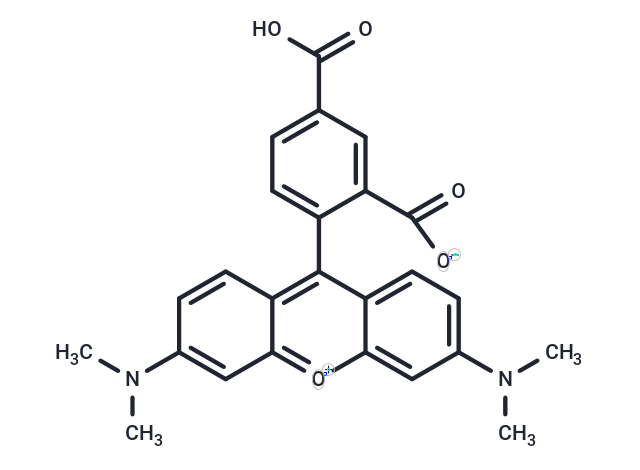Shopping Cart
Remove All Your shopping cart is currently empty
Your shopping cart is currently empty
5-TAMRA (5-Carboxytetramethylrhodamine) (5-Carboxytetramethylrhodamine) yields bright, pH-insensitive orange-red fluorescence (approximate excitation/emission maxima ~546/579) with good photostability.

| Pack Size | Price | USA Warehouse | Global Warehouse | Quantity |
|---|---|---|---|---|
| 10 mg | $38 | In Stock | In Stock | |
| 25 mg | $64 | In Stock | In Stock | |
| 50 mg | $97 | In Stock | In Stock | |
| 100 mg | $137 | In Stock | In Stock | |
| 200 mg | $198 | In Stock | In Stock | |
| 1 mL x 10 mM (in DMSO) | $29 | In Stock | In Stock |
| Description | 5-TAMRA (5-Carboxytetramethylrhodamine) (5-Carboxytetramethylrhodamine) yields bright, pH-insensitive orange-red fluorescence (approximate excitation/emission maxima ~546/579) with good photostability. |
| In vitro | I. Biomolecule labeling 1. Material preparation: 1) 5-TAMRA solution: Prepare a 1–10 mM solution and dissolve it in anhydrous DMF (N,N-dimethylformamide) or DMSO. 2) Target molecules (such as antibodies, nucleic acid probes, etc.). 3) Coupling buffer: Commonly used are PBS buffer or other appropriate biochemical buffers (pH 7.0–8.5). 4) Coupling reagents: such as EDC (1-ethyl-3-(3-dimethylaminopropyl)carbodiimide) or NHS (N-hydroxysuccinimide). 2. Steps: 1) Coupling reaction: Add 5-TAMRA solution and target molecules (such as antibodies, nucleic acid probes, etc.) to the coupling buffer at an appropriate molar ratio (usually 1:1 to 1:10), add coupling reagents (such as EDC or NHS) to activate the carboxyl groups on the molecules and promote the binding of 5-TAMRA to the amino groups on the target molecules. 2) Reaction conditions: React the reaction system at room temperature for 1-2 hours, or adjust the time and temperature according to the specific coupling reaction requirements. 3) Washing: Remove unreacted dyes and coupling reagents by dialysis, gel filtration or other appropriate methods. 4) Detection and analysis: Determine the fluorescence intensity of the labeled molecules by fluorescence spectrophotometer or fluorescence microscope. Usually use an excitation wavelength of 546 nm and an emission wavelength of 579 nm for detection. II. Real-time PCR labeling 1. Material preparation: 1) 5-TAMRA fluorescent probe (usually used as a reporter dye) is used in conjunction with FAM, VIC or other targeting dyes. 2) PCR primers and templates. 2. Steps: 1) Design probes: Match the 5-TAMRA-labeled probes to specific DNA sequences, usually selecting sequences with high specificity. 2) PCR reaction: Use the 5-TAMRA-labeled probes in real-time PCR experiments to detect changes in the fluorescent signal during PCR amplification. |
| Synonyms | 5-Carboxytetramethylrhodamine |
| Molecular Weight | 430.45 |
| Formula | C25H22N2O5 |
| Cas No. | 91809-66-4 |
| Smiles | CN(C)c1ccc2c(-c3ccc(cc3C([O-])=O)C(O)=O)c3ccc(cc3[o+]c2c1)N(C)C |
| Relative Density. | no data available |
| Color | Brown |
| Appearance | Solid |
| Storage | keep away from direct sunlight | Powder: -20°C for 3 years | In solvent: -80°C for 1 year | Shipping with blue ice/Shipping at ambient temperature. | |||||||||||||||||||||||||||||||||||
| Solubility Information | DMSO: 60 mg/mL (139.39 mM), Sonication is recommended. | |||||||||||||||||||||||||||||||||||
Solution Preparation Table | ||||||||||||||||||||||||||||||||||||
DMSO
| ||||||||||||||||||||||||||||||||||||
| Size | Quantity | Unit Price | Amount | Operation |
|---|

Copyright © 2015-2026 TargetMol Chemicals Inc. All Rights Reserved.